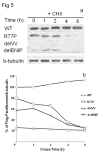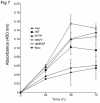Identification and functional characterization of three NoLS (nucleolar localisation signals) mutations of the CDC73 gene
- PMID: 24340015
- PMCID: PMC3855386
- DOI: 10.1371/journal.pone.0082292
Identification and functional characterization of three NoLS (nucleolar localisation signals) mutations of the CDC73 gene
Abstract
Hyperparathyroidism Jaw-Tumour Syndrome (HPT-JT) is characterized by primary hyperparathyroidism (PHPT), maxillary/mandible ossifying fibromas and by parathyroid carcinoma in 15% of cases. Inactivating mutations of the tumour suppressor CDC73/HRPT2 gene have been found in HPT-JT patients and also as genetic determinants of sporadic parathyroid carcinoma/atypical adenomas and, rarely, typical adenomas, in familial PHPT. Here we report the genetic and molecular analysis of the CDC73/HRPT2 gene in three patients affected by PHPT due to atypical and typical parathyroid adenomas, in one case belonging to familial PHPT. Flag-tagged WT and mutant CDC73/HRPT2 proteins were transiently transfected in HEK293 cells and functional assays were performed in order to investigate the effect of the variants on the whole protein expression, nuclear localization and cell overgrowth induction. We identified four CDC73/HRPT2 gene mutations, three germline (c.679_680delAG, p.Val85_Val86del and p.Glu81_Pro84del), one somatic (p.Arg77Pro). In three cases the mutation was located within the Nucleolar Localisation Signals (NoLS). The three NoLS variants led to instability either of the corresponding mutated protein or mRNA or both. When transfected in HEK293 cells, NoLS mutated proteins mislocalized with a predeliction for cytoplasmic or nucleo-cytoplasmic localization and, finally, they resulted in overgrowth, consistent with a dominant negative interfering effect in the presence of the endogenous protein.
Conflict of interest statement
Figures








Similar articles
-
Molecular genetics of syndromic and non-syndromic forms of parathyroid carcinoma.Hum Mutat. 2017 Dec;38(12):1621-1648. doi: 10.1002/humu.23337. Epub 2017 Sep 25. Hum Mutat. 2017. PMID: 28881068 Free PMC article. Review.
-
Tumor suppressor gene mutation in a patient with a history of hyperparathyroidism-jaw tumor syndrome and healed generalized osteitis fibrosa cystica: a case report and genetic pathophysiology review.J Oral Maxillofac Surg. 2015 Jan;73(1):194.e1-9. doi: 10.1016/j.joms.2014.09.008. Epub 2014 Sep 28. J Oral Maxillofac Surg. 2015. PMID: 25511968 Review.
-
CDC73-Related Disorders: Clinical Manifestations and Case Detection in Primary Hyperparathyroidism.J Clin Endocrinol Metab. 2017 Dec 1;102(12):4534-4540. doi: 10.1210/jc.2017-01249. J Clin Endocrinol Metab. 2017. PMID: 29040582
-
A Novel Mutation in a Patient with Hyperparathyroidism-Jaw Tumour Syndrome.Endocr Pathol. 2016 Jun;27(2):142-6. doi: 10.1007/s12022-016-9427-6. Endocr Pathol. 2016. PMID: 26995009
-
Large intragenic deletion of CDC73 (exons 4-10) in a three-generation hyperparathyroidism-jaw tumor (HPT-JT) syndrome family.BMC Med Genet. 2017 Aug 3;18(1):83. doi: 10.1186/s12881-017-0445-0. BMC Med Genet. 2017. PMID: 28774260 Free PMC article.
Cited by
-
Genotype of CDC73 germline mutation determines risk of parathyroid cancer.Endocr Relat Cancer. 2020 Sep;27(9):483-494. doi: 10.1530/ERC-20-0149. Endocr Relat Cancer. 2020. PMID: 32590342 Free PMC article.
-
Characterization of a new CDC73 missense mutation that impairs Parafibromin expression and nucleolar localization.PLoS One. 2014 May 19;9(5):e97994. doi: 10.1371/journal.pone.0097994. eCollection 2014. PLoS One. 2014. PMID: 24842573 Free PMC article.
-
Parafibromin Abnormalities in Ossifying Fibroma.J Endocr Soc. 2021 May 8;5(7):bvab087. doi: 10.1210/jendso/bvab087. eCollection 2021 Jul 1. J Endocr Soc. 2021. PMID: 34159287 Free PMC article.
-
A novel CDC73 gene mutation in an Italian family with hyperparathyroidism-jaw tumour (HPT-JT) syndrome.Cell Oncol (Dordr). 2014 Aug;37(4):281-8. doi: 10.1007/s13402-014-0187-3. Epub 2014 Aug 12. Cell Oncol (Dordr). 2014. PMID: 25113791
-
Molecular genetics of syndromic and non-syndromic forms of parathyroid carcinoma.Hum Mutat. 2017 Dec;38(12):1621-1648. doi: 10.1002/humu.23337. Epub 2017 Sep 25. Hum Mutat. 2017. PMID: 28881068 Free PMC article. Review.
References
Publication types
MeSH terms
Substances
Grants and funding
LinkOut - more resources
Full Text Sources
Other Literature Sources

